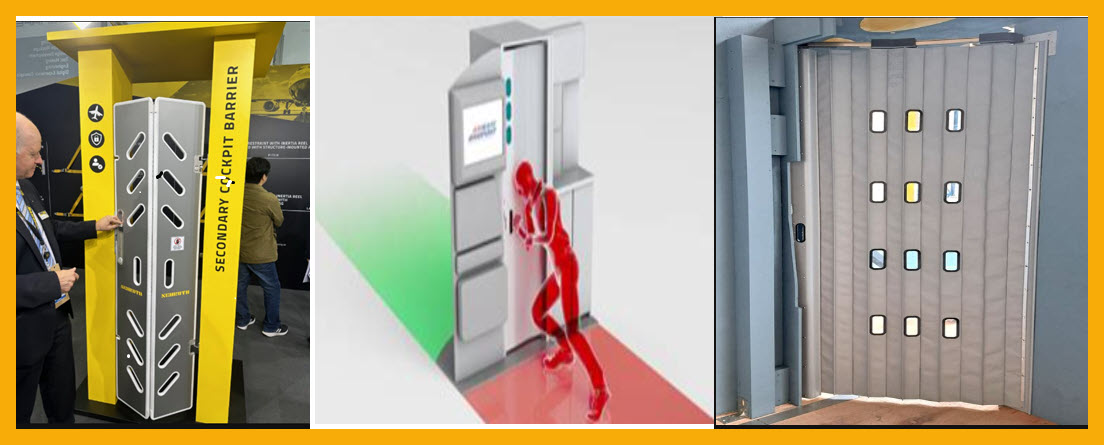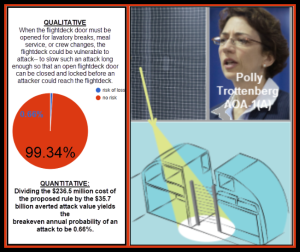The BIZZARE tale of the Cockpit BARRIER rule

In a document (not yet available under the federal register nor posted by a DOT/FAA press statement[1]), the implementation of the statutorily mandated “INSTALLED PHYSICAL SECONDARY BARRIERS” (IPSB) was deferred a year. This unusual action neatly fits with a series of similar steps in the unusual history behind the IPSB requirement.
The regulatory system was defined in 1946 when Congress enacted the ADMINISTRATIVE PROCEDURE ACT, 5 U.S.C. §§ 551–559. That statute established steps that are required before a proposed rule may become effective. Next both Executive Orders and statutory endorsement created a requirement that the Office of Management and Budget (OMB) perform or oversee COST-BENEFIT ANALYSES[2] of proposed federal regulations.
Generally, Congress passes statutes to ESTABLISH BROAD LEGAL FRAMEWORKS, RIGHTS, OBLIGATIONS, OR NATIONAL POLICY GOALS. The executive branch’s function has been to appropriately craft such imprecise guidance so as to make the resulting rule implementable, practical, effective and objective. That historical relationship, over time, has been adjusted. Increasingly, the legislation mandates exact wording for a to-be-enacted rule.
Section 336 of the FAA Reauthorization Act of 2018 (P.L. 115-254)(2018) mandated installation of IPSB on certain newly manufactured aircraft. In relevant part Congress enacted the following language
“Installation of a secondary flightdeck barrier on each NEW aircraft that is manufactured for delivery to a passenger air carrier in the United States operating under the provisions of part 121 of title 14, Code of Federal Regulations.”
Congress deferred to the DOT/FAA to write a regulation that specifies what a physical secondary barrier—typically a lockable gate or intrusion-resistant structure—that must be deployed whenever the cockpit door is open in flight. While it is clear that the aegis for the IPSB was the takeover of the three cockpits on 9/11, it was not obvious whether such a barrier would have been effective. Before 2018, aviation experienced a pilot locked out his cockpit mate in order to crash the plane into a mountain.
Those questions may have caused the FAA to delay issuing a proposal and it formed, on June 20, 2019, Aviation Rulemaking Advisory Committee with the assignment “to provide advice and recommendations… on the most effective ways to implement” a IPSB rule. They were convened by the FAA in March 2019, the group submitted its Recommendation Report[3] on February 27, 2020, and ARAC formally accepted and forwarded it to the FAA in March 2020. The rule languished until June 2023 when an FAA press release, discuss a new requirement that manufacturers install secondary cockpit barriers. The news report points out some pertinent issues while the agency summary is bereft of details.
Polly Trottenberg was named Acting Administrator of the Federal Aviation Administration on June 8, 2023, and the first notable action of her time in that position was to issue the final rule. On the same day, ALPA issues the following statement:
“Earlier today at a press conference together with the Federal Aviation Administration (FAA) and other pilot unions[4], the Air Line Pilots Association, Int’l (ALPA), commended the aviation regulator for issuing the final rule for the implementation of secondary barriers. Published today, the long-overdue final rule will mandate the installation of secondary barriers on all newly manufactured aircraft within two years.
“Twenty-two years ago this September, terrorists used passenger aircraft to kill nearly 3,000 of our fellow Americans and shattered our sense of safety and security. We responded to these attacks decisively and put multiple measures in place to prevent another tragedy like this from happening, BUT UNTIL NOW HAVE FAILED TO ACT TO INSTALL SECONDARY FLIGHT DECK DOOR BARRIERS,” SAID CAPT. JASON AMBROSI, ALPA PRESIDENT. “I applaud Acting FAA Administrator Polly Trottenberg for moving to implement this live-saving measure after years of needless delay.”
This was ALPA’s #1 priority and months before the rule was published; commented:
The ARAC released its report on February 27, which included recommendations essentially ignoring the work done by the RTCA in 2011. With ALPA input and direction, the final report was largely in line with the Association’s expectations, and ALPA supported the overall outcome. Since receiving the report, no other movement on this issue has occurred, nor has the FAA announced next steps.
With unusual alacrity an Advisory Circular No. 25.795-10 entitled “Installation of Physical Secondary Barriers for Transport Category Airplanes” and it offered advice for OEMs and operators how to install IPSBs. The AC:
“provides an acceptable means of showing compliance with the requirements of § 25.795(a)(4). Section 25.795(a)(4) requires installation of a physical secondary barrier in order to delay intrusion into the flightdeck”.
The most recent news, issued by the current Administration, delayed the implementation of the IPSB rule and explained the action was necessary for the FAA to “facilitate implementation”. The author of the Flight Global piece added that:
The airline associations had argued that meeting the deadline was impractical because manufacturers of the barriers had NOT YET RECEIVED REQUIRED APPROVALS FROM THE FAA. For that reason, airlines could not yet develop cockpit barrier training programmes, as also required by the FAA, the groups said.”
Curious that a 2023 AC WAS INADEQUATE for industry to develop the barriers or for the FAA to approve them. Not entirely surprising given a history beginning with
- unusually explicit directive by Congress (17 years after 9/11),
- five years of delay within the FAA rulemaking consideration,
- issuance soon after an Acting Administrator took office
and
- equally lightly documented press release extending the implementation date (especially since the reason for this decision was the lack of information needed to comply.)
FAA extends deadline for secondary cockpit barriers despite pilot union opposition
By Jon Hemmerdinger24 July 2025
The Federal Aviation Administration has given airlines another year to comply with a rule requiring NEW AIRCRAFT BE EQUIPPED WITH SECONDARY COCKPIT BARRIERS, despite opposition from the USA’s largest pilot union.
Trade groups Airlines for America and Regional Airline Association had requested extensions to a 25 August deadline.
At issue is a 2023 FAA rule requiring that airlines by 25 August equip new aircraft with so-called “INSTALLED PHYSICAL SECONDARY BARRIERS”. The devices supplement existing cockpit doors and are intended to better prevent intruders from entering cockpits.
The rule had been in the works for years, having been spurred by the September 2001 terrorist attacks in New York.
“The FAA granted a one-year exemption to install and use additional barriers on new commercial airplanes to protect against unauthorised access to the flight deck,” the FAA now says. “This will allow time to facilitate FAA certification and install the barriers.”
The airline associations had argued that meeting the deadline was impractical because manufacturers of the barriers had not yet received required approvals from the FAA. For that reason, airlines could not yet develop cockpit barrier training programmes, as also required by the FAA, the groups said.
The Air Line Pilots Association pushed back, saying the rule and its implementation were long overdue. It now expresses disappointment at the FAA’s decision.
“The FAA’s decision to grant airlines yet another delay on the secondary barrier rule is deeply disappointing and undermines our nation’s aviation security,” says union president Jason Ambrosi. “This pattern of endless delays must stop. Airlines have had ample time – two full years – to comply with this congressionally mandated safety requirement.”
[1] The below Flight Global article, along with multiple other stories, confirm this announcement without reference to a specific document.
[2] Executive Order 12866 (1993): Issued by President Clinton, this is the cornerstone directive requiring agencies to assess the costs and benefits of “significant” regulatory actions and submit them to OMB’s Office of Information and Regulatory Affairs (OIRA) for review. Executive Order 14094 (2023): Updated EO 12866 by raising the economic threshold for “significant” rules to $200 million and requiring inflation adjustments every three years. SEE ALSO Regulatory Flexibility Act (5 U.S.C. §§ 601–612): Paperwork Reduction Act (44 U.S.C. §§ 3501–3521): Unfunded Mandates Reform Act (2 U.S.C. §§ 1532–1538); OMB Circular A-4 (2003, revised 2023)
[3] Design Standards: Recommendations for the engineering specifications of Installed Physical Secondary Barriers (IPSBs), including resistance to intrusion and placement within aircraft cabins.
- Operational Procedures: Guidance on crew training and protocols for deploying the barrier during flightdeck door transitions.
- Applicability Limits: Advised against extending the requirement to:
- All-cargo aircraft
- Small aircraft used for short-haul flights
- Flights staffed by only one cabin crewmember
- Cost Estimates: Provided industry cost projections for installation and lifecycle maintenance.
These recommendations directly informed the FAA’s final rule issued in June 2023, which mandates IPSBs on newly manufactured aircraft delivered to U.S. passenger carriers starting August 25, 2025
[4] SWAPA, and CAPA …


